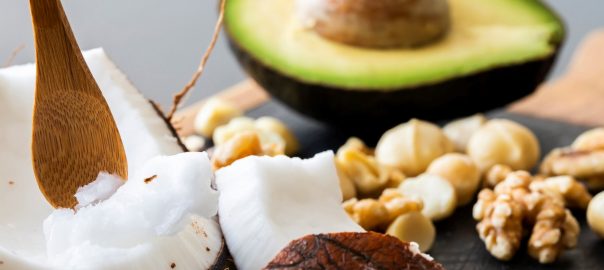
Explore Plant-Based Keto Diets
Pros and Cons of a Plant Based Keto Diet
Two big trends in diets are plant-based or vegan diets, and a low-carb high-fat or keto diet. Both of these have unique benefits for wellbeing and weight loss. So, you might be wondering if there is a way to combine both of these diets into one “super-diet.” In this article we explore the pros and cons of a plant-based keto diet as well as recipes that you can try at home. As with any major change to your diet, we recommend speaking to your doctor first, to see if it’s right for you.
What is a Plant-Based Keto Diet?
One challenge with the keto diet can be an over-emphasis on meats and dairy and not enough emphasis on plants! Low starch vegetables and greens are an essential part of any diet; they are important sources of fibre, vitamins and minerals that your body needs to perform essential functions, regulate digestion, improve fertility and contribute to healthy aging, skin, hair and nails. A plant-based diet can ensure you are getting enough of these micronutrients from whole, unprocessed food sources.
A plant-based keto diet may include aspects of vegan, vegetarian or pescatarian food sources that are low in carbs and high in fats. That can look something like this:
1. A focus on healthy fats (~70% of your diet). Plant-based sources include:
- Coconut oil
- Full fat coconut cream
- Avocados and Avocado oil
- Olives and olive oil
- Butter, ghee, cheese and eggs (vegetarian)
2. Moderate amounts of clean proteins (~20% of your diet):
- Nuts and seeds
- Soy products such as tofu and tempeh
- Eggs (vegetarian)
- Salmon and other fatty fish (pescatarian)
3. Small amounts of carbs which can come from low-starch vegetables and low-fructose fruits (<10% of your diet):
- Dark, leafy greens
- Broccoli
- Cauliflower
- Brussels sprouts
- Cabbage
- Asparagus
- Radishes
- Turnips
- Zucchini
- Berries
- Lemons
- Limes
- Grapefruit
Note that although carbs from vegetables and fruits make up the smallest part of a keto diet, it is important to eat enough of them at every meal. Be sure to understand how many grams of each macronutrient you need every day, based on your height, weight and age as the amount of fat, protein and carbs you need to achieve ketosis can vary widely from person to person. For example, one cup of leafy greens may contain just 2g-4g net carbs, while your daily carb intake may be set at 20g – meaning you can pile on the veggies at every meal.
Pros of a Plant-Based Keto Diet
More Micronutrients
As mentioned before, it is important to get enough micronutrients (vitamins and minerals) in your diet. An animal-based keto diet can lack some of these nutrients, especially if you are eating refined or processed meats and dairy products which can undergo manufacturing practices that strip the foods of their original nutrients. Fruits and vegetables are some of the most abundant sources of these important micronutrients.
More Fibre
Fibre is necessary for healthy digestion, keeping you full and satiated throughout the day, and regulating blood sugar levels. Fibre slows the absorption of food into the bloodstream which can help stabilize blood sugar levels and prevent rapid energy spikes.
Healthier Fats
The keto diet relies on fats as the body’s main energy source. However, not all fats are equally good for you. There are different types of fats, including trans fats, unsaturated fats and saturated fats. A lot of processed meat and dairy products can contain unhealthy trans and saturated fats and should be avoided, as consuming these can lead to inflammatory and cardiovascular diseases.
In contrast, many plant-based foods are great sources of healthy unsaturated and saturated fats. One exception in this category being “hydrogenated” or “partially hydrogenated” vegetable oils. The term hydrogenated indicates that these types of fats have undergone artificial processing that converts the fats into trans fats, which can imbalance levels of cholesterol in the body in favour of bad cholesterol. This has been linked to several diseases including heart disease, stroke and type 2 diabetes.
Improved Energy Levels
Eating a plant-based diet has been shown to have positive effects on energy levels. This could be due to the digestive benefits of plant-based foods which mean that your body doesn’t have to use as much energy to digest your food. Also, the absence of artificial sugars and unhealthy fats that can leave you feeling tired or bogged down can play a role in higher energy levels. Finally, plant foods also contain higher levels of nutrients, which support the body in a variety of functions that can keep you moving and your brain sharp throughout the day.
Stable Blood Sugar Levels
A plant-based diet can be a great option for those wanting to reduce their risk of type 2 diabetes. This is due to the fact that plant-based foods contain more fibre, which regulates digestion and insulin levels. Plant-based diets also allow many people to maintain a healthier weight, which can lower diabetes risk. Finally, foods derived from plants contain higher levels of other beneficial compounds such as antioxidants which can promote insulin sensitivity.
Minimized Exposure to Artificial Toxins
A plant-based diet requires a focus on whole foods, instead of conventional processed non-organic foods. In place of packaged products, you are more likely to be consuming whole, unprocessed vegetables, fruits, nuts and seeds which means that you avoid the health complications that come with artificial additives and preservatives. Whether you choose to go the plant-based route or not, always shop for minimally processed foods and organic where possible.
Cons of a Plant-Based Keto Diet
Although a plant-based keto diet has many nutritional benefits, there are still some things to point out before diving in.
Omega 3 Sources
Omega 3s are a necessary type of “good fat” that the body does not produce on its own and must be obtained from the diet. Omega 3s can be found in both plant and animal sources, but in different forms. Plant sources usually contain omega 3 ALA fatty acids, which are necessary in their own right, but we also need EPAs and DHAs which are found in fish and meat. If you don’t want to consume meat, you should be taking an omega 3 supplement to ensure you are getting required levels of EPA and DHA fatty acids.
It is also good to be wary of the higher contents of omega 6s found in nuts and seeds. Your body requires both omega 3s and 6s, and you should aim to consume a larger amount of omega 3s to avoid the inflammatory effects of excess omega 6s.
Protein Sources
One of the main criticisms of a plant-based keto diet is limited sources of proteins. While a traditional vegan diet containing whole grains, legumes, nuts, seeds, soy products and vegetables contains adequate and healthy protein levels, a lot of these items are off the table for keto dieters. That said, since proteins make up only about 20% of the keto diet, this shouldn’t be a problem for those wanting to try a plant-based keto diet. One great way to get protein from plant sources is to look for vegan protein powders and make a keto-friendly smoothie with coconut or MCT oil, a handful of low carb fruits and a serving or two of veggies. Soy products such as tofu and tempeh are also great low-carb complete proteins (meaning they contain all essential amino acids, also found in eggs and meat).
Finding the Right Balance
Plant-based is a loose term that could mean whatever you want it to. For some, this might mean 100% plant-based and for others it could mean focusing on plant sources of foods while still incorporating things like eggs, fish and dairy. Finally, it could also mean that maybe you choose one day of the week to make plant-based meals. Any way to incorporate more plant-based foods into your diet is good for you and the environment.
Plant-Based Keto Recipes
If you are having a hard time envisioning what a typical day on a plant-based (vegetarian) keto diet may look, here’s a sample menu you could take inspiration from:
Breakfast: Hot Low Carb Breakfast Cereal topped with a handful of berries.
Snack 1: Vegan protein powder shake with coconut or MCT oil, berries, spinach and nut milk.
Lunch: Scrambled tofu (recipe) with bell peppers, greens, and onions wrapped in a Low Carb Tortilla with a side of avocado.
Snack 2: A handful of nuts or raw veggies with Walden Farms Dips or tahini (sesame seed butter).
Dinner: Cauliflower Crust pizza with vegan or dairy cheese, plant-based sausage, olives and other veggies.
Dessert: Yummy vegan keto chia seed pudding!
We found a few other plant-based keto recipes on the web that we think are worth sharing:
- Coconut Veggie Stir-Fry with Cauliflower Rice
- Roasted Beet Caprese Salad with Avocado and Toasted Almonds
- Vegan Keto Walnut Chili
- Portobello Mushroom Pizzas
- Low Carb Vegan Cauliflower Coconut Curry
- Keto Vegan Pesto Zucchini Noodles
The options really are endless! We encourage you to do your own research online to find easy vegan keto recipes to try – even just once a week. Best of luck!
Share Your Story!
If you liked this article or want to share your plant-based keto recipes, visit our Facebook page or tag us on Instagram.
We also love to stay connected with our Weekly Newsletters for updates on the latest products and specials, and feel free to leave a Google Review with your Low Carb Grocery experiences!






